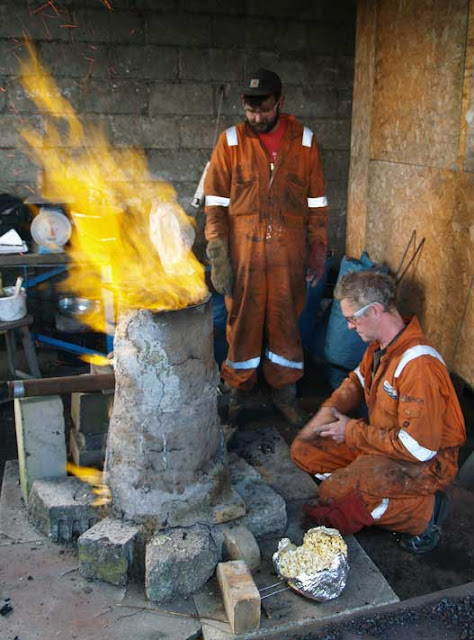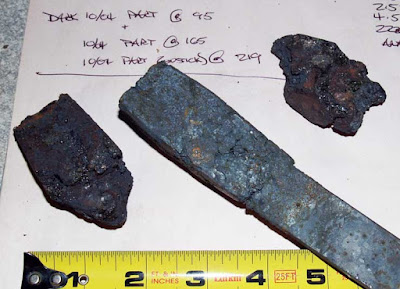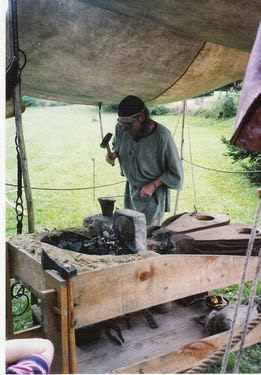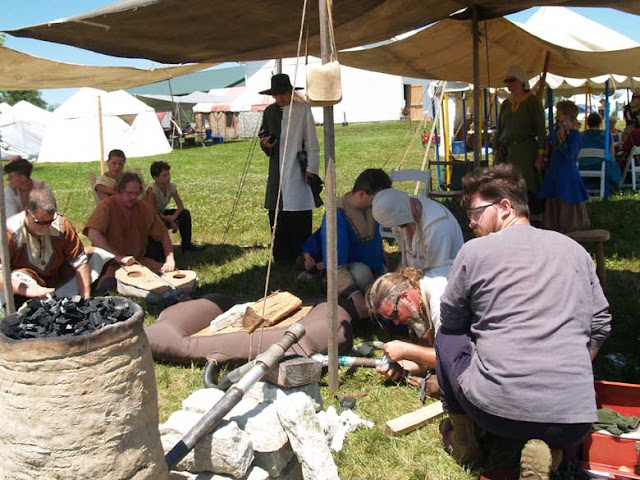An iron smelt event
October 31
Wareham
I have been casting around for some direction to head with the long set of individual iron smelting experiments, now after the better part of 20 years of undertaking.
 |
| Start of the insanity : L'Anse aux Meadows - Summer, 2001 |
Starting with that initial week long research workshop at L'Anse aux Meadows NHSC for Parks Canada, the first years were spent just figuring out how to even get any iron at all (!) I dragged members of the Dark Ages Re-Creation Company into the madness. It would not be until my 6th attempt (# 4 with DARC) in Fall of 2004, that there would actually be a workable iron bloom produced.
I was lucky to fall in with Lee Sauder & Skip Williams, and Mike McCarthy. Mike would boldly start the original 'Early Iron' symposium series, the four of us forming the 'Gangue aux Fer'
 |
| Sauder / Williams / McCarthy (me in the back) - Early Iron 1, 2004 |
Lee would launch an annual series of workshops at his home base in Lexington, Virginia, running 10 - 14 days every March from 2005 through to 2011. At 'Smeltfest', furnaces were built and fired daily, investigating the individual variables which effected the success (or failure!) of bloomery iron production in small scale furnaces. Over those years there would be a number of additions, with Shelton Brower and Steve Mankowski (of Colonial Williamsburg) becoming other core members. Another significant accomplishment would be the development of the 'Aristotle' re-melting furnace, which we tested extensively in 2009.
 |
| Brower / Sauder / DIck Sargent / Williams / Mankowski - Smeltfest 2009 |
Here at Wareham, the experience and knowledge gained from all this trial and error experimentation would start to be applied 'backwards' towards specific historic historical prototypes, potential equipment, and possible methods - most specifically to those from Northern European / Viking Age archaeology.
The first specific archaeological series was with Kevin Smith, based on his excavations at Hals in Iceland, with experimental work starting in October of 2007. A total of 8 full smelts were undertaken in this series, extending through to October 2016.
 |
| Neil Peterson, Icelandic grass sod furnace - Hals #8, 2016 |
Part of the reason that the Hals series ran so long is that the DARC team was approached by Parks Canada in 2009 about running a full scale re-creation of the iron smelt by the Norse at Vinland, as a public demonstration event in 2010. A total of five experimental smelts were ran in this initial series, to be followed up later by another demonstration event in 2017. Both these smelts at L'Anse aux Meadows NHSC would use all circa 1000 type equipment, other than required safety equipment.
 |
| Mark Pilgrim (LAM) / Dave Cox (DARC) / me, Vinland #5 (at L'Anse aux Meadows), 2010 |
- Turf To Tools at the Scottish Sculpture Workshop (Lumsden, Aberdeenshire). This based on their local Pictish history (so post Roman / pre Viking). This included one test smelt here in Canada, then four at SSW, in 2014. The second segment of the project was in 2016 and was composed of another three smelts in Scotland. There was a third segment planned to complete this overall combination research and artistic project for September 2020, but COVID lead to postponement.
- Work at the Scottish Crannogg Centre, based on Early Celtic Iron Age. This series has included one test at Wareham, staff training on site in Aberfeldy in 2016, then a demonstration smelt in 2017.
 |
| Uist Corrigan / Eden Jolly (SSW), T2TA, 2016 |
Along the way :
- The development of an primary bog iron ore analog, based on the physical characteristics of the natural material found in excavations at L'Anse aux Meadows.
- A number of full scale tests of various historic human powered air systems. (experimentation possibly remains here.)
In total, to date I have personally mounted over 85 individual iron smelts. The majority have been intended to answer specific experimental questions, or to accumulate enough working experience to allow useful data to be gathered. There have been a significant number undertaken as public demonstrations, at international symposiums, or as training sessions for students.
'What's next?'
When my long time collaborator and smelting partner Neil Peterson was up to Wareham last week (for a day rendering bloom pieces into useful working bars), he asked what the plan was. The last experimental smelt was the 'Bones' test in June. Although there could be a continuation there, truthfully I don't feel there is much insight to be gained that would be worth the investment in materials, time and effort. I had started some background on early Irish bowl furnaces, but not enough at this point to realistically frame a working experimental series based on this.
We considered the current test furnace, the stone block, built for a second Icelandic research project over 2019. This furnace has been fired four times at this point, and had suffered some structural damage on its last use (course over Thanksgiving). Given the shift to colder late fall temperatures (below freezing at night, mid single digits daytime) and the general lack of a clear direction, I decided to repair this furnace for one use.
 | |
| Condition of the stone block after Oct 11 smelt. The red line is where the original lintel stone (above the extraction arch) had broken out. | |
I turn 65 just days after the already scheduled Samhain Iron Smelt, set for Saturday 31 October.
With tongue in cheek, Neil said " 65 in 65. You could smelt 65 kg of ore. "
Now, the largest volume smelts I personally have ever done have been with 45 kg of ore ( Smeltfest 2005). These also resulted in some of the largest blooms, into the range of plus 20 kg. Attempting 65 kg could increase everything by 40 %, importantly the amount of charcoal and raw working time ( * ). Bloom yield also increases steeply with larger ore amounts. I'm not really sure the furnace on hand would contain what likely would be such a massive bloom!
Past use of this specific furnace has shown it will accept alternating 2 and 3 kg charges at the end (this against standard 1.8 kg charcoal amounts, burn rate averaging 14 minutes.) The stone mass has been found to take significantly longer to come up to working temperature (in the past about 2 + hours). With our normal roughly 30 kg ore amounts, the elapsed time of the main sequence has been in the range of 5 hours.That all suggests an attempt at a 65 kg smelt would add about another 3 - 3 1/2 hours to the main smelt sequence, suggesting a total experimental time (first pre-heat to final extraction) of 12 1/2 hours. ( ** )
Just recently, the metal bands on my cut wooden barrel slack tub failed. One of the 'mystic' things here is that tub has never been emptied since I set up the forge at Wareham, back in 1990. (This included some water gathered from the point where Black Duck Brook mixes with the ocean, just downstream from the Smelter Hut at L'Anse aux Meadows.) In the process of replacing the bands, 30 years of accumulated iron forge scale was collected. This material, 2.5 kg, had been added to the analog mix being made in preparation for Saturday's smelt. This material is still drying, but there should be at least 30 - 32 kg of analog.
As I have mentioned before, the region around Wareham does not contain any naturally occurring iron ore. This has meant over the years having to use a wide range of types (and quality!) of ores, perhaps more than any other long working team :
- primary bog iron ore - Newfoundland / Denmark
- 'Lexington Brown' limonite - Virginia
- industrial taconite - Ontario / Scotland
- hematite grit - Quebec
- red iron oxide as analog
- black iron oxide as analog
It has occurred to me that I do have plenty of the other ore types we have worked with here over past experiments. Right now I have a good large amount of variable quality Lexington limonite, including a 'smelt's worth' already roasted an partially broken for size. There is also about 40 kg of hematite grit remaining.
This suggests starting with 6.5 kg of the limonite (pretty much were we started, and a tribute to Lee and Skip), followed by 6.5 kg of the hematite (which actually was the next ore body which we worked with, easily available in Ontario back at that point). The limonite, which I gathered, does tend to be on the lower iron content side. This should be balanced with the hematite, which if anything tends to be too rich (lacking in silica for slag formation). The balance will be the current analog mix.
This is an 'open invitational' event - with limits imposed by COVID.
What that means is that interested individuals may attend, but do need to contact me directly before attending, ideally by e-mail
Core working team is likely to be gathered from those with past experience. Although observers are welcome, this is not a 'teaching' styled event. (Ok - we all know it is hard to shut me up!)
- Masking will be required
- Distancing will be in effect
- Visitors will have no access to the residence.
( * ) This not strictly true. At the later end of a smelt sequence, charges are typically large, 1 : 1 with charcoal, or even more.
( ** ) The limiting factor may turn out to be charcoal. Between what I have on hand here, and what Neil has in store, the total looks to be 12 bags / 100 kg. A normal 30 kg smelt typically consumes about 60 kg. Hopefully this will be 'just enough'.
One problem right now is that with COVID, the normally used 'Maple Leaf' brand via Home Hardware is completely out of stock - and back ordered to at least Spring 2021. Recently Canadian Tire was able to secure a bulk order of Royal Oak out of the USA. Neil grabbed a large quantity, but stores quickly ran through that stock.
















